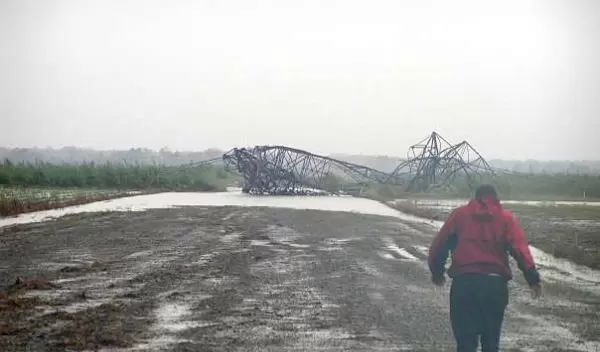
Students Venture Into the Hearts of Violent Storms
Ever wondered what it's like being up close and personal with some of the most violent storms on Earth? That's often just a normal day for students and faculty at Texas Tech University, who study nature's tempests such as supercell thunderstorms and hurricanes.
Researchers brave the wind, rain and hail to set up instruments to collect valuable data that can be used to understand the behavior of such extreme events, and to build better, stronger buildings to withstand them.
Instrumentation
To complete our missions, a variety of equipment and instruments are used. Our main observing platform has been affectionately dubbed Stick-Net, named for its resemblance to a stick-figure. The 24 Stick-Nets were designed and built entirely by Texas Tech students, including National Science Foundation (NSF) IGERT students in wind science and engineering like myself, as well as atmospheric science students.
Each Stick-Net consists of three parts: a tripod with wind-sensing instruments mounted on top, a data acquisition box that collects and stores the data, and a gray battery box that extends the instrument's run-time in a hurricane. The Stick-Nets travel in covered trailers and 4x4 pickup trucks, and it takes two people about two minutes to deploy a station for a thunderstorm and about five minutes for a hurricane configuration.
Severe thunderstorm Stick-Net missions
For the past three years, Stick-Nets have been used during the spring to collect weather data from severe thunderstorms making their way through the Great Plains. Texas Tech teams have traveled as far as Minnesota to intercept these storms. During thunderstorm missions, our fleet of Stick-Net vehicles consists of four trucks, each with two or three people and five to seven Stick-Net probes. We caravan to a target location and wait for storms to develop, adjusting our location along the way. Once we select a target storm, we identify suitable deployment roadways. People in two of the trucks begin setting up the instruments in a large-scale array, with 3.2-6.4 kilometers (2-4 miles) between probes, about an hour before the storm will pass our target road.
Others in the remaining trucks wait until the storm gets closer to begin their setup, so they can adjust their position if needed to ensure an intercept. Then they lay out a fine-scale array, with one mile or less between the probes.
The goal of the missions is to collect data near the heart of the storm, to better understand the near-storm environment and its effect. The Stick-Nets are vital to accomplishing this goal, as weather observations are quite sparse, especially across the vast areas of the Great Plains.
In spring 2009, students and faculty from Texas Tech will be deploying the Stick-Nets as part of VORTEX2, a project funded primarily by NSF and NOAA for the study of tornadoes.
Hurricane Stick-Net missions
The 2008 Atlantic hurricane season was the first time the Stick-Nets had been used for hurricane studies. During hurricane missions, the team is much smaller, with only two trucks, each pulling a trailer with 12 Stick-Nets, and two people per truck. During the season, we made deployments for Hurricanes Dolly and Ike in Texas, as well as Hurricane Gustav in Louisiana.
Hurricane missions are far more complicated than thunderstorm deployments because care must be taken to ensure the probes are elevated high enough that they will not be swept away by storm surge, and it's often harder to find open areas to place the Stick-Nets where they will not be shielded by trees or buildings.
Retrieving instruments after the storm is a daunting task, too! Downed trees and power lines, not to mention flooded areas and muddy roads, make pickup a messy and challenging time. But the data collected during the year was worth all of the effort. A Stick-Net measured a wind gust of over 174 kilometers per hour (108 mph) in Hurricane Ike! And, deployments provided complete observation records even as conventional observing stations failed.
The group hopes that this kind of data can be provided in real-time to weather forecasters, emergency managers and first responders. We also hope that engineers will be able to use high quality data like ours to build stronger buildings, so we will not see the kind of damage caused during recent hurricane seasons.
-- Tanya Brown, Texas Tech University tanya.m.brown@ttu.edu
This Behind the Scenes article was provided to LiveScience in partnership with the National Science Foundation.


